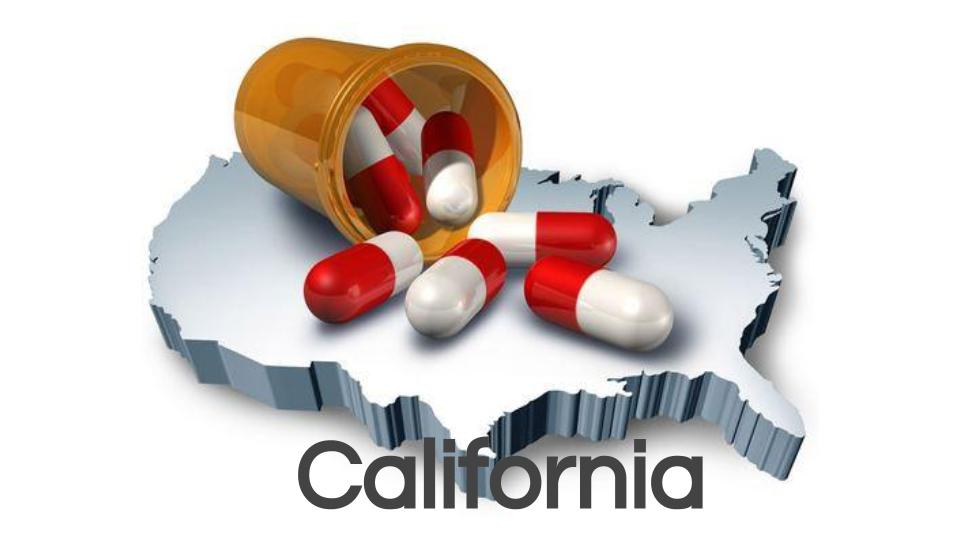STATE OF AFFAIRS: California Wins Case Against Big Pharma Organization Hopes Other States Follow the Lead SACRAMENTO, Calif. – The Golden State is known for being home to the biggest stars, “free thinkers” and the famous Golden Gate Bridge, and in addition the bright lights of Hollywood and the beautiful cliff-lined beaches, California is also home to 57 painkiller prescriptions per 100 people, according to the CDC. With that number comes a lot of responsibility, and one California county is making sure taxpayers don’t bear the sole burden of it. Alameda County challenged Big Pharma to help with the cleanup. In 2012, the county adopted a safe drug disposal ordinance, the first of its kind in the United States. The ordinance holds pharmaceutical companies responsible for designing and implementing prescription take-backs programs in the county. This is where citizens can bring their unused or unwanted prescriptions to a safe location for disposal. The practice not only keeps hazardous materials out of the environment, but also arguably aids in reducing use by removing them from homes. In a recent report from the Tennessee Department of Mental Health and Substance Use Services, 55% of those addicted to prescription painkillers say they got them from a friend or relative and 17.3% say they received the meds from a doctor. Only 4% say they got their prescriptions from a drug dealer. A group of 3 pharmaceutical associations challenged the decision, and in May of this year, the U.S. Supreme Court denied the request to hear their case. While this was a victory for the county of Alameda, Executive Director of the California Product Stewardship Council Heidi Sanborn says there’s more work to be done, and she hopes the program will expand to more states, as it most recently has in Washington. “These companies design, operate and fund medicine take back programs in several other countries to protect public health,” says Sanborn. “The arguments against doing it in the U.S. range from it causing a rise in the price of the drugs to being an unfair financial burden on pharmaceutical commerce.” Sanborn goes on to explain that the same drugs sold in the U.S. are 2-3 times higher than in other countries, still the major pharmaceutical companies are able to operate several prescription take-back programs in Belgium (which had a 33% increase in meds from 2000-2011), France (where 15,000 tons are collected annually), Hungary (4000 programs nationally), Portugal (over 99% of pharmacies acted as take-backs in 2011), Spain (70% of households utilize the program there), British Columbia in Canada (their program started voluntarily 15 years ago and not it is mandated by law), Mexico (over 4000 collection locations in over 22 states), Brazil (22 tons collected there in 2013), and Colombia, with over 685 locations covering 43% of the population). So, why then, is it such an impossible financial burden in the U.S.? The answer could lie in the fact that we’re a country that ALLOWS it to be. Could it be Big Pharma quite simply lost this case because a proof of burden couldn’t be found? According to Alameda County, the cost for the program is at most 1 penny for every $10 of prescription drugs sold there. “It is unreasonable to consider that these companies are overburdened by the cost,” says Sanborn. “Almost a billion dollars worth of drugs were sold in Alameda County in 2010. The estimated cost for a prescription take-back program was $300,000. Both sides agreed to the estimate of $1 million to take that argument out of the proceedings.” Organizations like the Pharmaceutical Researchers and Manufacturers of America (PhRMA) are set up and paid for by the major drug companies to protect their interests in commerce. But, to put it simply, the argument that prescription take-back programs will bankrupt pharmaceutical companies or cause a reason for them to raise prices in prescriptions just doesn’t hold water. According to DrugWatch.com, Pharmaceutical sales topped $1 trillion in 2014 alone. 10 of the largest drug companies in the world made $429.4 billion – half of which are headquartered in the U.S. (Johnson & Johnson, Eli Lilly, Merck, Pfizer and Abbott). With over a thousand lobbyists on their payroll in Washington, D.C., the groups spent nearly $3 billion in lobbying since 2000 and donated over $15 million in campaign contributions JUST in 2013. Our country joins New Zealand as one of ONLY TWO in the world that allows prescription drug advertisements on television. Many times these ads yield a 200-300% return in sales. Comparatively, with a trillion dollar profit annually JUST in the U.S., the industry arguably could afford nearly 40,000 prescription take-back programs in this country alone (there are currently just over 3,000 counties in the U.S.), so that leaves potentially $990 million to spare, not taking into account the cost it takes to maintain various business expenses such as payroll. To put it in perspective, technology superpower Apple, Inc. only made a humble $100 billion annually in recent years. (NOTE: Apple has no known link to any pharmaceutical company or association and was just used here as an illustration as one of the top 5 companies in the U.S.) “We want to help organizations all over the country do the same thing, so we formed the National Stewardship Action Council to advocate nationally for these policies” says Sanborn. “We haven’t lost a single vote on a local level.” Since Alameda’s decision, 6 other counties have followed suit, but Sanborn says it’s just one piece of the puzzle that’s going to help reduce prescription use and safely dispose of them in our communities. President Barack Obama just last week released a report, listing 4 key pillars in a plan to combat addiction in our country, one of which was to help fund more prescription take-backs from a federal level. “This is just ONE thing we can do to make sure these chemicals don’t end up in the wrong hands,” says Sanborn. “And we don’t want them flushed into our water system”. Sanborn says her office has seen firsthand the effects of California’s drug problem. “We are finding needles everywhere,” says Sanborn. “Drug users are hiding in the stairways and doing drugs in buildings throughout midtown Sacramento. It’s way bigger than a lot of people think, but they’re starting to put it together. We just want to offer people a safe, free and convenient disposal option. That’s the first step.” And California is leading the way. Anyone interested in starting an initiative in their county, or donating to the advocacy work, can contact the National Stewardship Action Council at: 1822 21st Street, Suite #200 Sacramento, CA 95811 916.402.3911 They will walk you through the steps you need to take to make an Extended Producer Responsibility (EPR) law in your local government. Sanborn says they are already helping counties in other states across the U.S. successfully emulate what was done in Alameda County. To give a tax deductible donation to the California Product Stewardship Council, click here: https://www.calpsc.org/donate We are so proud of the work that Sanborn and the CPSC are doing, and will monitor the situation closely to keep our readers up to date on the progress. If you or someone you know is battling an addiction to prescription drugs, you can call our 24 hour call center at 1.888.614.2251, or use the “chat” feature in the lower right hand corner of this page to chat with one of our Treatment Specialists.  Heidi Sanborn is the Executive Director of the California Product Stewardship Council. She has been a leader in the solid waste industry in California for 22 years, working with industry, government and the public to reduce waste, improve product design and recyclability, and implement cost-effective projects and policies which protect the health and the environment. Collaborating with local government leaders, Heidi was one of two original co-directors of CPSC in 2007 to change the way product waste is funded and managed in California; she has since become a nationally recognized thought leader and driver for innovative product stewardship programs across the country. Heidi’s collaborative, tenacious problem-solving approach has delivered unprecedented success in developing Extended Producer Responsibility (EPR) public policy at national, state and local levels. She has engaged diverse stakeholder groups to create and promote best-in-class product stewardship programs for pharmaceuticals, mercury thermostats, carpets, paint, fluorescent lights, and batteries. Nationally, Heidi was instrumental in adoption of EPR policies by the National League of Cities (NLC) and the US Conference of Mayors. Through CPSC, she successfully co-sponsored AB 2347 with the Sierra Club, creating a comprehensive statewide take back program for mercury thermostats to reduce mercury pollution in the environment. Heidi has also influenced the formation of product stewardship councils in three key states, which respectively passed EPR legislation. Maybe most significantly, Heidi provided technical support to Alameda County as it adopted the first EPR ordinance in the country which was then challenged by PhRMA and two other producer associations and Alameda won in the lower court, but was appealed and heard in the 9th circuit court of appeals awaiting a ruling. Alameda is leading the country in determining the “legal rules of the road” in regards to local government authority to hold producers of products responsible for their management at end of life. Heidi speaks throughout the world to raise awareness about product stewardship. She has been frequently published on the topic and done interviews on National Public Radio and quoted in the Wall Street Journal on the subject. Heidi earned a B.A. in Political Science – Public Service from the University of California at Davis and a Master of Public Administration from the University of Southern California.
Heidi Sanborn is the Executive Director of the California Product Stewardship Council. She has been a leader in the solid waste industry in California for 22 years, working with industry, government and the public to reduce waste, improve product design and recyclability, and implement cost-effective projects and policies which protect the health and the environment. Collaborating with local government leaders, Heidi was one of two original co-directors of CPSC in 2007 to change the way product waste is funded and managed in California; she has since become a nationally recognized thought leader and driver for innovative product stewardship programs across the country. Heidi’s collaborative, tenacious problem-solving approach has delivered unprecedented success in developing Extended Producer Responsibility (EPR) public policy at national, state and local levels. She has engaged diverse stakeholder groups to create and promote best-in-class product stewardship programs for pharmaceuticals, mercury thermostats, carpets, paint, fluorescent lights, and batteries. Nationally, Heidi was instrumental in adoption of EPR policies by the National League of Cities (NLC) and the US Conference of Mayors. Through CPSC, she successfully co-sponsored AB 2347 with the Sierra Club, creating a comprehensive statewide take back program for mercury thermostats to reduce mercury pollution in the environment. Heidi has also influenced the formation of product stewardship councils in three key states, which respectively passed EPR legislation. Maybe most significantly, Heidi provided technical support to Alameda County as it adopted the first EPR ordinance in the country which was then challenged by PhRMA and two other producer associations and Alameda won in the lower court, but was appealed and heard in the 9th circuit court of appeals awaiting a ruling. Alameda is leading the country in determining the “legal rules of the road” in regards to local government authority to hold producers of products responsible for their management at end of life. Heidi speaks throughout the world to raise awareness about product stewardship. She has been frequently published on the topic and done interviews on National Public Radio and quoted in the Wall Street Journal on the subject. Heidi earned a B.A. in Political Science – Public Service from the University of California at Davis and a Master of Public Administration from the University of Southern California.
STATE OF AFFAIRS: California Wins Case Against Big Pharma


